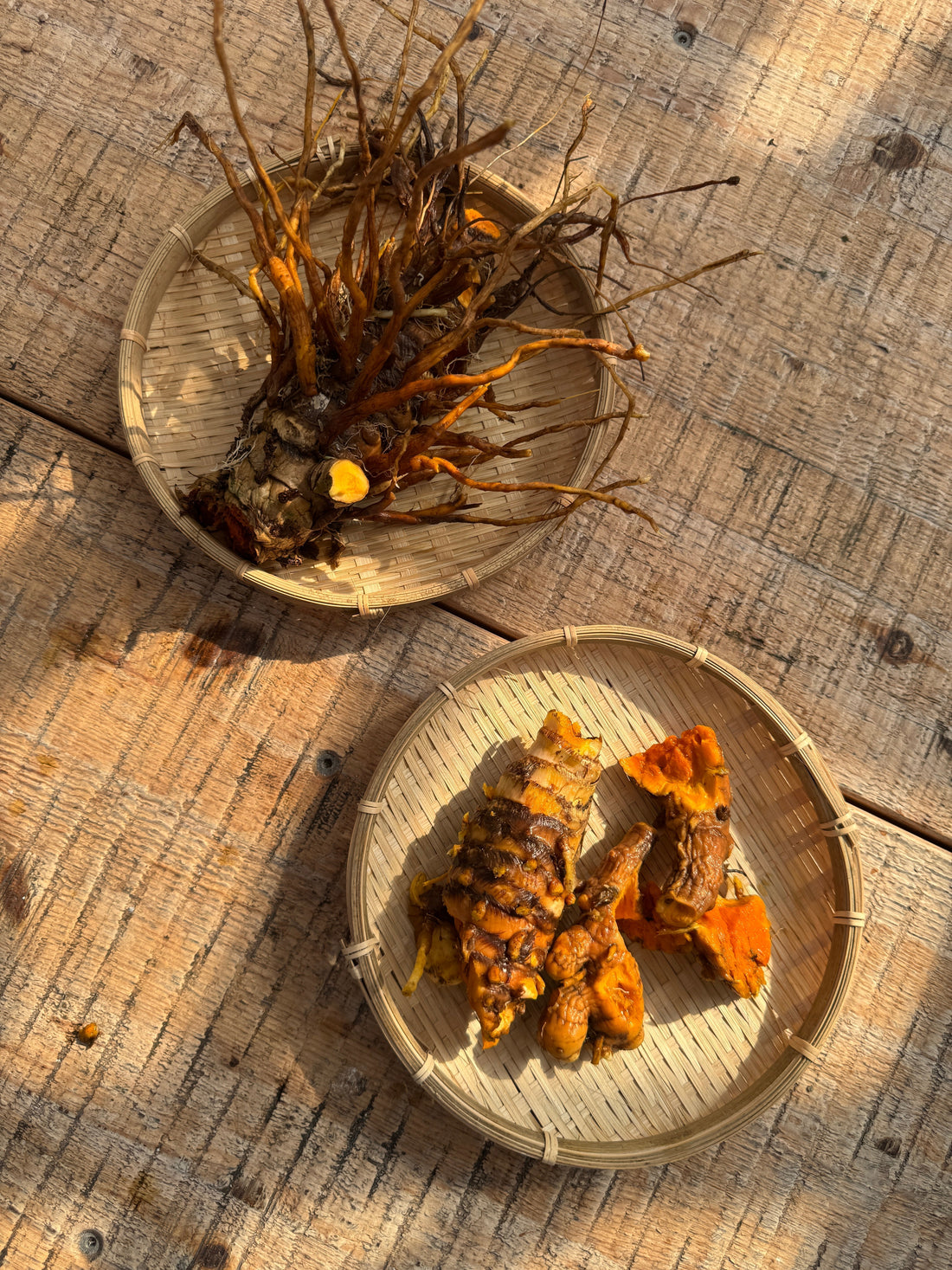
Reflection & Recipes: Roots & Remedies, a collaboration with Kebon Dapor
Kebon Dapor, which translates to "Kitchen Garden", invited us to co-host a special tasting and learning session. This collaborative event was part of one of their final gatherings at their current plot, and we celebrated with a session full of kampong spirit.

About Kebon Dapor


Kebon Dapor is a greenhouse inspired by traditional kampong aesthetics, artfully embodying the rich tapestry of Malay heritage through exquisite Batik decor and inviting wooden furnishings. It’s a joy to wander through their edible garden, where free-range chickens roam and nature flourishes in harmony!
Mother Turmeric Harvest

Photos credit to Kebon Dapor
The main highlight of the event was a Mother Turmeric harvest, which had been growing for over a year. This main rhizome, or 'mother,' became the base for cultivating yeasts for the fermented drinks we presented during the session. In our local markets, most of the turmeric sold consists of secondary or smaller rhizomes that grow off the mother plant.

We have created exclusive turmeric-themed drinks and a special medicinal dessert, all designed to inspire you to use turmeric in innovative ways beyond traditional cooking. Flavour highlights include turmeric, coconut, cardamom, pineapple, lime, mint, and chilli.
Turmeric has its origins in the diverse cultures of South Asia, particularly India, where it has been valued for its medicinal properties for thousands of years. The active compound in turmeric (Curcuma longa), curcumin, is recognised for its potent anti-inflammatory and antioxidant properties. Research suggests curcumin may help manage arthritis, cardiovascular issues, and certain types of cancer. In addition to its health benefits, turmeric enriches culinary traditions across various cultures, enhancing both the flavour and colour of dishes.
Despite its rich history and health-promoting properties, curcumin has low bioavailability, which is why it is often combined with compounds like piperine (found in black peppercorns) or fat carriers such as coconut oil or ghee to improve absorption. According to the World Council for Health, curcumin is also included in the top ten essentials for detoxifying spike proteins.
Further reading:
- Hewlings, S. J., & Kalman, D. S. (2017). Curcumin: A Review of Its Effects on Human Health. Foods, 6(10). Link
- McCullough, P. A., & Hulscher, N. (2025). Risk stratification for future cardiac arrest after COVID-19 vaccination. World Journal of Cardiology, 17(2). Link
- Spike Protein Detox Guide by World Council for Health. Link
Our Welcome Drink: Jamu
We began our session with a welcome drink of Jamu, a medicinal herbal tonic made from turmeric that originates from Java, Indonesia. This tonic has been used for generations, dating back approximately 1,200 years to the Mataram Kingdom. It is consumed for its anti-inflammatory and immunity-boosting benefits, as well as for detoxification and medical compresses. Traditionally, Jamu includes a mix of barks, seeds, leaves, and flowers, reflecting each household's understanding of native herbs. There is no single recipe for Jamu, as unique variations have developed in different regions. In modern Indonesia, it is commonly sold at street stalls run by herbalists.

Our Jamu features a unique twist by using Pineapple tea as the base and a natural sweetener, making the tonic more appealing to a wider audience. This approach embraces a zero-waste philosophy and emphasizes the benefits of pineapple rinds and cores, which would otherwise be discarded. The pineapple cores are too fibrous to juice or break down, but are rich in bromelain, a digestive enzyme that aids in protein breakdown and supports gut health. Pineapples are also a rich source of vitamins A and C, which contribute to immune function and healthy skin.



Thank you, Russell Law for the beautiful photos!
We also included our crowd's favourite and very special Fermented Jamu. You can read more about it in one of our articles: https://www.amanitakombucha.com/blogs/articles/fermented-jamu-a-traditional-herbal-medicine
Gardening: Plant-a-Turmeric


Photos credit to Russell Law
Our friend Oi Lian, an enthusiastic gardener and soil advocate, taught us how to select fresh turmeric rhizomes and plant them successfully. Every attendee also got to bring back a potted plant with their own rhizome to try growing on their own. Nothing beats being able to use your fresh harvest in the kitchen.
Turmeric Chai
Before our dessert was served, we enjoyed a warm cup of creamy Turmeric Chai. The drink was made with coconut milk infused with a blend of spices, including ginger, nutmeg, black pepper, cinnamon, and clove. It was sweetened with a touch of coconut sugar and finished with a pinch of sea salt to enhance the flavors. This delightful chai truly warms both the stomach and the heart.
Piña Cottata Recipe

Photos credit to Kebon Dapor
Piña colada + Panna cotta = Piña cottata
Inspired by the flavors of the renowned Piña colada, a cocktail made with rum, cream of coconut, and pineapple juice, our dessert takes a different approach. We’ve created a version called Piña cottata, which is alcohol-free and does not contain gelatin, unlike the classic Italian dessert, Panna cotta, a sweetened cream set with gelatin.
In our Piña cottata, we combine Arabian and French influences by infusing the coconut cream pudding with cardamom and rose, a combination previously featured in our Two of Something Kombucha. The pineapple element is beautifully arranged atop the pudding, with a fiery hint of cayenne pepper, and is topped with fresh, homegrown mint.
The 'Pudding':
Coconut milk: 300ml
Oat groat milk: 105ml (can substitute with any other milk or use full coconut milk)
Agar powder (red algae): 0.75g (Less is more!)
Arrowroot starch: 7.5g
Vanilla: 2.5g
Honey: 9g (you can replace it with any sweetener to make the recipe vegan)
Cardamom: about 5 pods
Rose: ~4g
First, heat the coconut milk. In a separate bowl, whisk the agar powder and arrowroot starch into oat groat milk at room temperature, ensuring everything is well combined. The starch may settle at the bottom over time, so make sure to stir it well before adding it to the gently boiling coconut milk.

Add the remaining spices and herbs to the mixture and allow it to heat for about 20 to 30 minutes, ensuring that the flavors are well incorporated, as agar only activates with heat. For a smoother texture, strain the mixture to remove any solids. Then, pour it into your desired molds; it can take the shape of any glass, for example.

Notes: You can substitute oat groat 'milk' with any other type of 'milk' or use full coconut milk. I wanted to add a variety of nutrients to make the dessert as nutritious as it is tasty, so I included homemade oat groat milk (made from 60g of soaked oat groats, blended with 1L of cool, filtered water, and sweetened with soaked Medjool dates). Oat groats are the whole oat grain, including the nutrient-rich bran, the fibrous germ, and the starchy endosperm. They are the least processed form of oats, with only the tough outer husk removed.

Instead of using arrowroot starch, you can also opt for corn starch or tapioca starch. We chose arrowroot for its additional nutritional benefits and to align with the theme of this event, Roots & Remedies, which highlights the diversity of ingredients to inspire creativity in the kitchen.

A small amount of agar powder goes a long way. Through experimentation, we have found that the suggested quantity is suitable for achieving a pudding-like consistency while firming up the texture just right. We've tried setting it without the agar powder, but it remained a thick cream slurry rather than achieving the integrity of a panna cotta.

When using cardamom spice, be cautious not to add too much, as it can become overpowering. Start with a small amount and taste the mixture after simmering for a while. Initially, the flavors may not have fully developed from the green pods.
Coconut Crumble Base
The Piña cottata is served atop a Coconut Crumble.

Coconut flour: 100g
Flaxseed flour: 66g (can substitute with almond flour)
Mango syrup: 80ml (can substitute with any sweetener)
Ghee: 66g (can substitute with softened butter)
Mix all the ingredients together in a blender. Spoon the mixture into your serving container and press it down. During the event, we used glass jars for serving.
Notes: Coconut flour acts like a sponge, absorbing oils and liquids due to its very high fiber content. As a result, it requires a much higher ratio of wet ingredients to create a proper structure. If you use only coconut flour, you will need significantly more ghee to achieve a cohesive crumble. You can substitute flaxseed flour with almond flour, which contains more protein and fat, contributing to better binding and a less crumbly texture.
The mango syrup was created because we had a batch preserved from the previous mango season that was blended with Japanese myoga. We wanted to add a subtle touch of this flavour, but really, you cannot taste it much, as the ghee itself with coconut flour is overpowering.If you would like it to remain unsweetened, substitute it with more ghee (or butter), as long as it holds the crumble together.

Photo credit to Jovena from gentle.sg, Forest Bathing Singapore
Pineapple Coulis
On the top layer is a golden yellow pineapple coulis with turmeric. A coulis is essentially fruit that has been broken down, pureed, and cooked into a smooth sauce without added processed sugars. Because pineapples are naturally sweet, we balanced the flavor with fresh lemon juice and added some arrowroot starch to thicken it slightly, since pineapples don't contain much natural pectin.

To prepare the coulis, start with fresh pineapples and blend them first to achieve a smooth sauce. Pineapples are more fibrous than berries, so they do not break down entirely during cooking. We incorporated turmeric for its medicinal benefits, as the entire menu was designed to creatively use this root. Add lemon juice and 2 teaspoons of arrowroot starch. After cooking, strain the sauce for a smoother texture and let it cool before serving.
Community and Connections
Much of our gathering focused on connecting with the community and inspiring one another as we embarked on our herbalism and fermentation journeys, sharing ideas and experiences. The tasting sessions made it easy to fall in love with herbs and spices, reminding everyone of their roots and how simple it is to incorporate them into our diets. At The Amanita Collective, we don't believe in competition; each time we come together, we experience a genuine sense of belonging to a larger community of herbalists and fermenters. We are truly happy to be a part of it!

Photo credit to Kebon Dapor
We want to express our gratitude to our hosts for their beautiful space and to everyone who joined us at Kebon Dapor’s gathering. It was a wonderful experience to connect with new cultured friends and reconnect with familiar faces before their move. We're thrilled that you had the opportunity to try our medicinal turmeric desserts and drinks.
If our work resonates with you and you would like to join our community of herbalists and fermentors, please leave us a message through our contact page. We are currently developing a community channel that will be invite-only. In the meantime, if you’d like to schedule a curated menu tasting session, you can reach us via our contact page as well.
Stay Rooted, Stay Cultured,
Sheila
